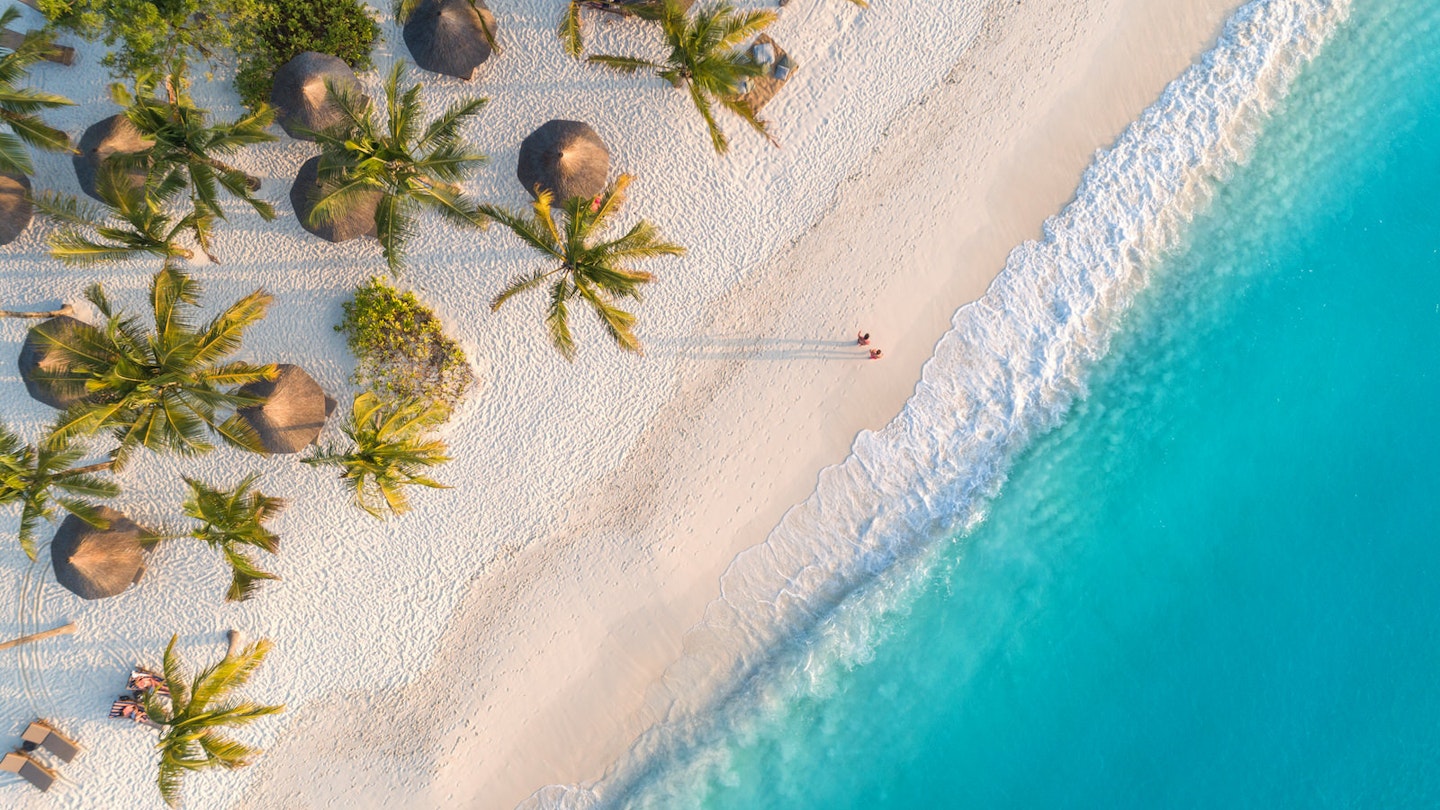The allure of Zanzibar is timeless. White sands and turquoise waters ring the island, while African, Indian, Arabic, and Persian influences intertwine in Stone Town, creating a rich cultural backdrop. If it is your first time visiting Tanzania’s most famous island, here are some tips to get started.
1. Beaches
Zanzibar’s beaches are justifiably famous. Fine white sands edge clear turquoise waters, traditional Arabic dhows sail into the dawn, silhouetted against pastel-tinted skies, and coconut palms sway gently in the breeze. Whether as post-safari relaxation or as a stand-alone destination, the beaches on Zanzibar’s east coast and around its northern tip offer a quintessential tropical island paradise. Each beach has its own unique personality:
- Paje: Known for its kitesurfing.
- Matemwe: Offers a more relaxed vibe with its powdery sands and glimpses of village life.
- Nungwi: A blend of tradition and contemporary life with fishing boats and western-style hotels.
- Kendwa: Maintains a laid-back atmosphere but allows swimming at any time.
- Pongwe: A quiet escape perfect for those wishing to get away from the crowds.
- Jambiani: Famous for its stunning turquoise waters and coral-rag houses, ideal for experiencing local life.
All the beaches are within a one to two hour drive from Stone Town. Transportation is affordable and frequent, making it feasible to base yourself at the beaches and explore Stone Town on a series of day trips.

2. Stone Town
Zanzibar Town is the island’s main settlement, with the historical old Stone Town being its heart and soul. It’s a fantastic place to immerse yourself in island rhythms. Start your exploration at Forodhani Gardens, a lively stretch of seafront where locals gather in the early evening to watch the sun go down. Young men leap from the seawall into the harbor waters, while children play and women in bui-bui (black shawls) socialize.
Across from the gardens is the massive Old Fort, built by Omani Arabs in 1698. Here, you can also find the imposing House of Wonders, famous for the largest carved doors in East Africa. Wander through Stone Town’s maze of narrow alleyways, stopping at the Palace Museum for insights into the Omani sultanate of the 19th century. Don’t miss worthwhile stops such as the beautiful Aga Khan and Ijumaa mosques, Hamamni Persian Baths, and the Anglican Cathedral, which hosts a moving Slave Memorial and East Africa Slave Trade Exhibit. Conclude your visit at the bustling Darajani Market, where vibrant textiles, fruit, and spices await exploration.
3. Jozani-Chwaka National Park
Jozani is the island’s largest indigenous forest area, showcasing the vegetation that once covered much of Zanzibar. It is renowned for the endangered Zanzibar red colobus monkeys. The park also hosts other monkey species, duikers, bushbabies, and over 40 types of birds. Jozani can be visited easily as a day trip from Zanzibar Town or as a stopping point to the beaches, requiring just a couple of hours to walk the forest trail and appreciate the natural beauty.
4. Spice Tours
Once, spices dominated the economy of the Zanzibar Archipelago. Although the spice trade has diminished, indulging in a spice tour of the island’s plantations is an enjoyable and informative excursion. These tours allow visitors to see, taste, and smell a variety of spices, herbs, and fruits—including cinnamon, cloves, vanilla, nutmeg, jackfruit, and lemongrass. Tours can be arranged through local tour companies and often include a meal, with some offering visits to local schools or cooperatives.

5. Diving and Snorkelling
The waters off northeastern Zanzibar provide excellent diving experiences, featuring vibrant coral reefs, wall dives, and a delightful array of fish. There is also rewarding diving available off-shore from Stone Town, with diverse corals and wreck dives. Visitors can choose from many dive companies in the main beach destinations including Nungwi, Kendwa, Matemwe, and Paje, as well as in Stone Town, enjoying water temperatures around 27°C and good visibility.
Make It Happen
Frequent and fast flights to Zanzibar from Dar es Salaam take about 30 minutes and cost between US$45 and US$80 one-way. Alternatively, daily ferry connections to and from the mainland take about two hours and cost US$35 one-way. Upon arrival, you’ll need to go through brief immigration formalities, so consider utilizing advance-arrangement pick-up services provided by most hotels for convenience.
Zanzibar boasts a wide selection of accommodation. In Stone Town, budget-friendly options include Jambo Guest House and Lost & Found. Mid-range choices comprise Beyt al-Salaam and Tembo House Hotel. For those seeking luxury, options include Kisiwa House or Emerson Spice.
On the beaches, consider staying at Demani Lodge in Paje for budget accommodation or Seles Bungalows in Matemwe. Mid-range accommodations include Mnarani Beach Cottages in east Nungwi or Bellevue Guesthouse, just north of Paje. Lastly, top-end choices include Pongwe Beach Hotel in Pongwe or Matemwe Lodge in Matemwe.





